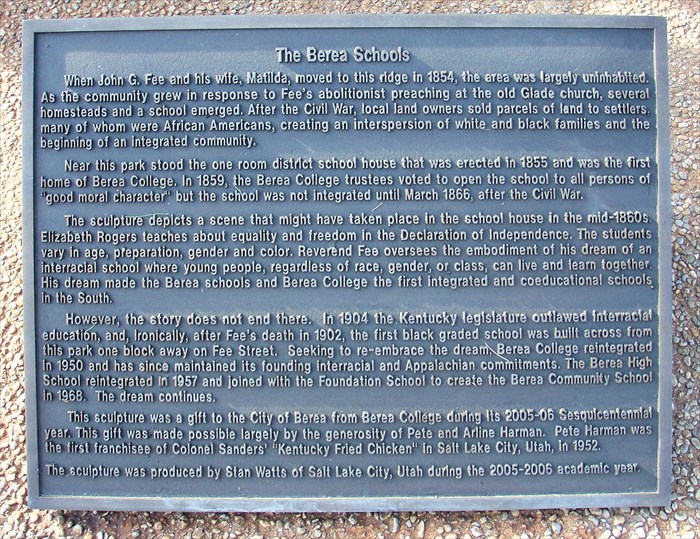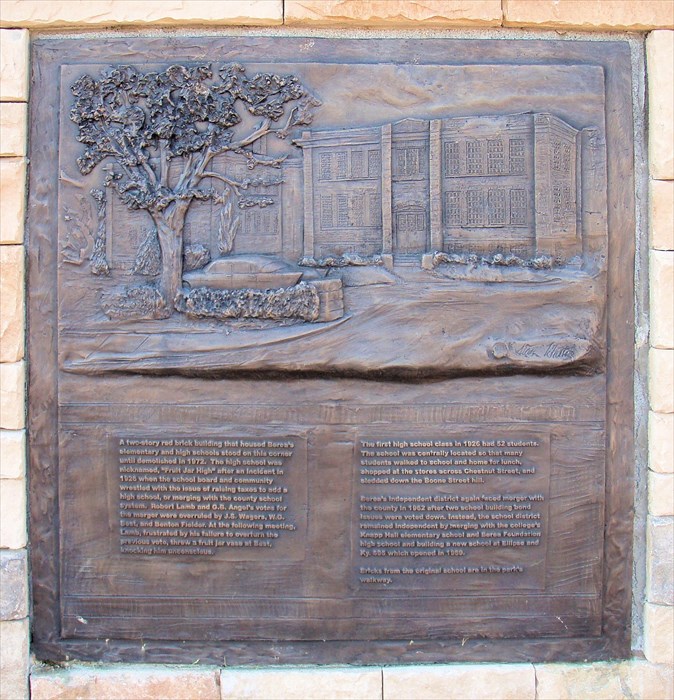These sculptures, by Stan Watts, were commissioned to commemorate the sesquicentennial of Berea college. Depicted are Rev. John Fee and Elizabeth Rogers with students.
Bricks from the original school have been used to pave this plaza which also has several benches. It is located on Chestnut street as one enters town from the west.

The Berea Schools
When John G. Fee and his wife, Matilda, moved to this ridge in 1854, the area was largely uninhabited.
As the community grew in response to Fee's abolitionist preaching at the old Glad church, several
homesteads and a school emerged. After the Civil War, local land owners sold parcels of land to settler,
many of whom were African Americans,creating an interspersion of whit and black families and the
beginning of an integrated community.
Near this park stood the one room district school house that was that was erected in 1855 and was the first
home of Berea College. In 1859, the Berea College trustees voted to open the school to all persons of
"good moral character" but the school was not integrated until March 1866, after the Civil War.
The sculpture depicts a scene that might have taken place in the school house in the mid-1860s.
Elizabeth Rogers teaches about equality and freedom in the Declaration of Independence. The students
vary in age, preparation, gender and color. Reverend Fee oversees the embodiment of his dream of an
interracial school where young people, regardless of race,gender, or class, can live and learn together.
His dream made the Berea schools and Berea College the first integrated and coeducational schools
in the South.
However, the story does not end there. In 1904 the Kentucky legislature outlawed interracial
education, and, ironically, after Fee's death in 1902, the first black graded school was built across from
this park one block away on Fee Street. Seeking to re-embrace the dream, Berea College reintegrated
in 1950 and has since maintained its founding interracial and Appalachian commitments. The Berea High
School reintegrated in 1957 and joined with the Foundation School to create the Berea Community School
in 1968. The dream continues.
This sculpture was a gift to the City of Berea from Berea College during its 2005-06 Sesquicentennial
year. This gift was made possible largely by the generosity of Pete and Arline Harman. Pete Harman was
the first franchise of Colonel Sanders' "Kentucky Fried Chicken" in Salt Lake City, Utah, in 1952.
The sculpture was produced by Stan Watts of Salt Lake City, Utah during the 2005-2006 academic year

A two-story red brick building that housed Berea's
elementary and high schools stood on this corner
until it was demolished in 1972. The high school was
nickname, "Fruit Jar High" after an incident in
1926 when the school board and community
wrestled with the issue of raising taxes to add a
high school, or merging with the county school
system. Robert Lamb and G.B. Angel's votes for
this merger were overruled by J.S. Wagers, W.C.
Best, and Benton Fielder. At the following meeting,
Lamb, frustrated by his failure to overturn the
previous vote, threw a fruit jar vase at Best,
knocking him unconscious.
===
The first high school class in 1926 had 52 students
The school was centrally located so that many
students walked to school and home for lunch,
shopped at the stores across Chestnut Street, and
sledded down the Boone Street hill.
Berea's Independent district again faced merger with
the county in 1962 after two school building bond
issues were voted down. Instead, the school district
remained independent by merging with the college's
Knapp Hall elementary school and Berea Foundation
high school and building a new school at Ellipse and
Ky. 595 which opened in 1969.
Bricks from the original school are in the park's
walkway.
A Brief History of Berea
Early Berea, The Glade
In 1850, this area of southern Madison County was called the Glade. There was no town, just a loose community of scattered farms known primarily for its racetrack and citizens who were sympathetic to emancipation. Since the early 1840?, Cassius Clay, a large landowner in Madison County, had sought to build a community in the Glade which would be a base for his own high political ambitions and the abolitionist cause. Located between the solid slavocracy of the Bluegrass and the mountains, he hoped the Glade would provide a gateway into a political base in the mountains. He sold land to prominent non-slaveholders at nominal cost and encouraged abolitionist missionaries to come to the area.
In 1853, Clay offered his friend Reverend John G. Fee, of Lewis County, Kentucky, a free track of land to move to the Glade. With some reluctance, Fee decided to move, and in 1854 accepted ten acres upon the ridge. With the help of local supporters and other missionaries from the American Missionary Association, Fee established a church, a school and tiny village. Asked by Clay to name the new settlement, Fee called it Berea after the Biblical town where the people ?eceived the Word with all readiness of mind? This tiny village became the center of an abolitionist mission field as Fee directed a band of teachers and preachers in Madison, Jackson and Rockcastle Counties. Although never a significant political threat, the Berea Community was enough of an irritant that prominent Madison County slave owners drove Fee and 94 other supporters from the state in late 1859 and early 1860.
After the Civil War, the Fees and some other exiles returned to Berea to reestablish their vision of an interracial school and community. In January 1866, the Berea Literary Institute opened its doors. Despite predictions that the admission of blacks would destroy the school, the founders of Berea were able to achieve their vision to a large degree during the last half of the 19th century. By 1889 the total enrollment was approximately 450 students in primary, secondary and college departments. Large numbers of former slaves moved to Berea because of the opportunity that the community provided. Berea recruited black students; Union Church welcomed blacks into the congregation; new jobs were available; and the college sold town lots on the condition that families live next to families of a different race. Maps from this period show that black residences were indeed interspersed among white throughout the town.
The former slaves took advantage of the opportunities they had. A large number of black graduates went on to distinguished careers throughout the country. The 1900 census cited 12.8% of all Madison County farms as black-owned, compared to 4.8% statewide; most of these were in the area surrounding Berea. This census also showed that most black men outside of town were farm owners, and that few black women in the area were domestics.
The achievements of this noble vision made the subsequent events all the more tragic. In 1904, the Kentucky Legislature passed the Day Law forbidding interracial education, and Berea College chose to focus on the education of mountain whites. Disillusioned and frustrated by the lack of educational and economic opportunities they once had. Most blacks moved away, and Berea became a segregated town.